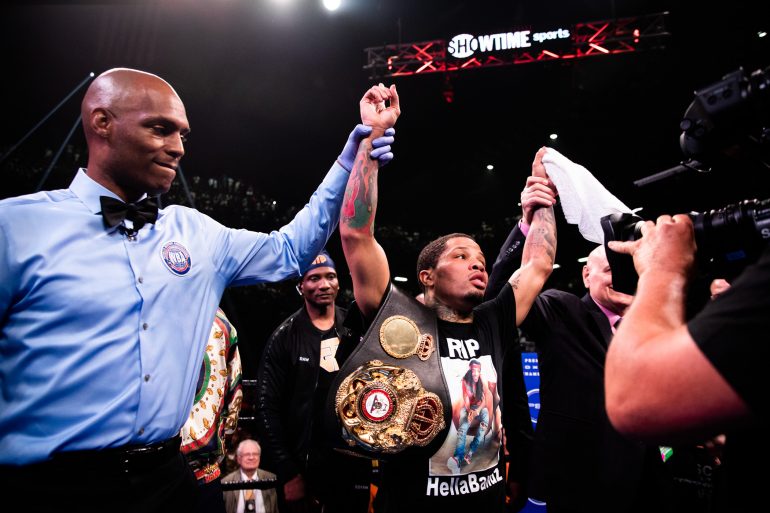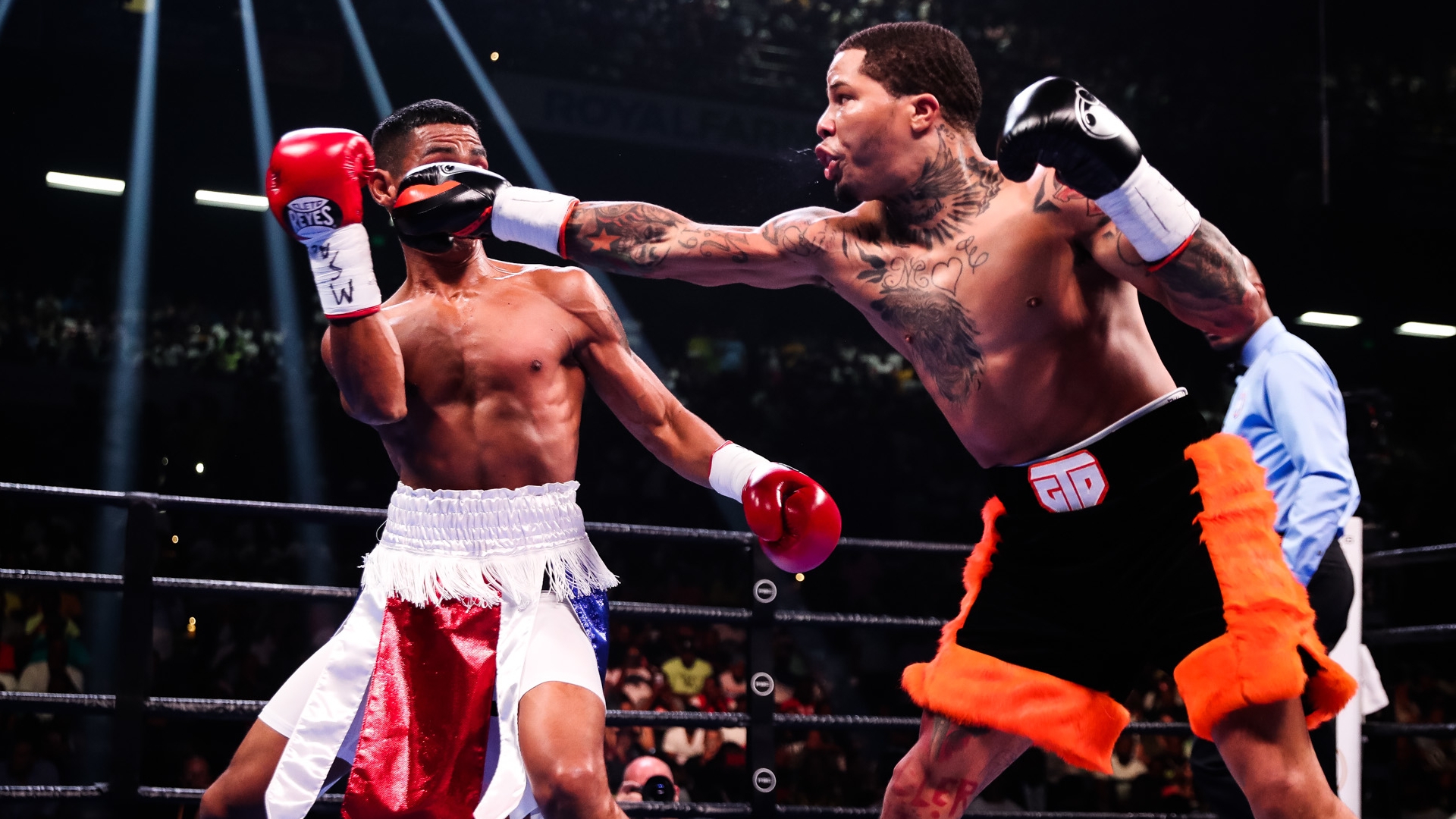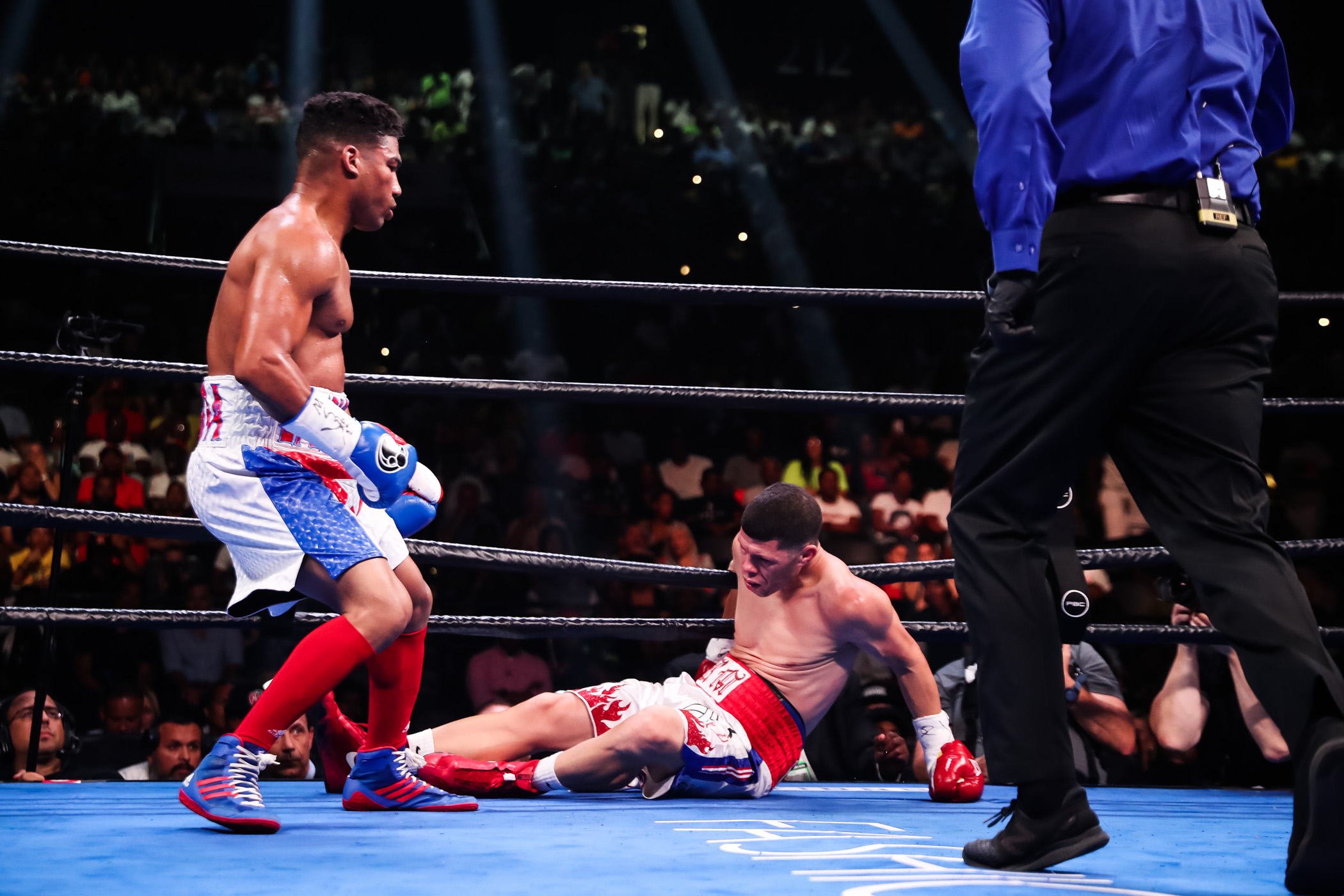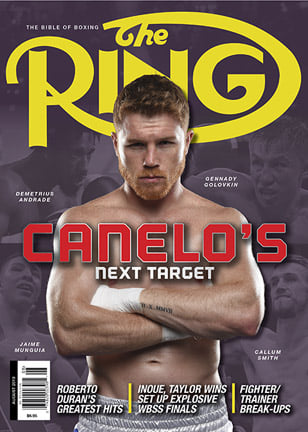The Travelin’ Man goes to Baltimore: Part Two

Please click here to read Part One.
Saturday, July 27 (continued): Self-belief can be an underdog’s most powerful weapon and WBA junior lightweight mandatory challenger Ricardo “El Cientifico” Nunez had it in abundance.
“I do not have any fear of Gervonta Davis,” Nunez told The Ring’s Anson Wainwright through promoter Rogelio Espino earlier this week. “I respect him but I’m doing the best training camp of my career because the fight is in his hometown and I do not want the judges to have to work. (Davis) is a boxer of good speed and power but that does not scare me. I hope we make a great fight and that there is no excuse after I beat him.”
He also told Showtime broadcasters Barry Tompkins, Al Bernstein, Paulie Malignaggi, Brian Custer and Steve Farhood at the fighter meeting that he, not Davis, was the true puncher in the fight despite Davis’ KO ratio of .952 (21-0, 20 knockouts) and Nunez’s .792 (21-3, 19 KO). Perhaps that’s because nine of Nunez’s last 10 victories had come by knockout and his fifth round stoppage of Yogli Herrera in July 2017 saw him average an ungodly 123.6 punches per round. Hardly the work rate of a fighter nicknamed “The Scientist,” would you agree?
However as formidable as self-belief can be for a challenger, the joy a champion derives from defending his title in his hometown is even more so. That joy was written all over Davis’ face as he soaked in the ear-splitting support of a sell-out crowd of 14,686 fans inside the Royal Farms Arena. It is a scene about which all fighters dream but, if Davis’ expression was an indicator, the reality far surpassed his imagined script. Once the opening bell sounded, however, Davis proceeded to turn his fulfilled dream into Nunez’s nightmare.

Gervonta Davis (right) vs. Ricardo Nunez. Photo credit: Amanda Westcott/Showtime)
Although Nunez wisely refrained from the whirlwind attack that eventually sunk Herrera, the first round was lively as Nunez landed seven of his 40 punches to Davis’ 12 of 62. Interestingly Davis’ 12 connects were evenly divided between his jab (6 of 44) and his power shots (6 of 18) while Nunez’s punch selection was intelligently tilted toward jabs (23 jabs, 17 power shots) in order to maintain plenty of space between himself and the champion. Both showed professional poise amid the highly-charged environment; Davis kept his cool even after his connects drew massive cheers while the challenger maintained his calm as he tried to solve the southpaw puzzle that was in front of him. Through the bout, the man called “Tank” planned his work, worked his plan and eventually cashed in with the sensational finish his audience expected him to deliver.
With 1:40 remaining in round two, the fighters fell into a clinch. Nunez, expecting a break from nearby referee Harvey Dock, relaxed his body and waited for the official to move in. The opportunistic Davis, who was in better position to determine that Dock would not break them, nailed Nunez with a massive left to the jaw that buckled the challenger’s legs and ignited a sonic wave of noise from the Davis partisans. As Nunez tried to weather the storm, the raging Davis connected with a devastating left to the head that propelled the challenger’s bending upper body into the ropes – which could have been called a “but-for-the-ropes” knockdown – then another right-left that moved Dock to intervene at the 1:33 mark.
“I saw (Nunez) get hit with a couple of big shots and I decided to stop it,” Dock said in Joe Santoliquito’s fight report. I thought Nunez was defenseless at that point – and he was. Tank punched him and he kept on coming. Nunez dropped his hands and he was unable to defend himself so I have to stop the fight.”
Although the stoppage was viewed as premature by some, I was perfectly fine with it – even without the backdrop of the deaths of Maxim Dadashev and Hugo Santillan. In the seconds before Dock’s move Nunez showed definitive signs of duress – his legs and upper body buckling and his head snapping from multiple angles. Therefore I interpreted Dock’s intervention as one designed to prevent the further destruction that would have made for excellent highlight reels but also might have negatively affected Nunez’s future. Dock had to walk a fine line – a line illustrated by the split opinions concerning the timing of the stoppage – but that split meant there was at least some justification for it. If lightning-quick stoppages preceded with signs of duress are OK in mixed-martial arts – and they are – then I believe actions such as Dock’s should be acceptable as long as the italicized caveat is also present.
Davis’ blowtorch finish rendered the final CompuBox numbers moot but those numbers were fairly competitive as Davis led 21-17 overall, 6-4 jabs and 15-13 power while also posting narrow accuracy gaps of 24%-22% overall, 12%-11% jabs and 39%-31% power. A telling stat: Davis landed 45% of his power shots in round two (9 of 20) and he appeared in line to land even more. Dock, however, did not let that happen. Good for him. Good for Davis. And especially good for Nunez.
*
Despite Davis’ titanic knockout record, more than a few fighters still want to be his next opponent. Yuriorkis Gamboa is one of them and his brilliant second round knockout over former three-time 130-pound titlist Roman Martinez produced the perfect infomercial for a potential Davis-Gamboa match. At age 37, Gamboa has retained a remarkable percentage of the hand and foot speed that defined his best years and, for the first time in a long time, he produced explosive offense without having to pay for it with a flash knockdown (or two or three or four).
“I had said in the fighter meetings that it’s genetics. I have explosiveness, I have speed and, at this age, I still have what it takes,” Gamboa said after the fight through Showtime’s Felix DeJesus.
He certainly had what it took to take out Martinez. Following a first round that saw Gamboa out-throw the hesitant Martinez 47-24 and out-land him 9-5 overall and 7-3 power, the 2004 Olympic gold medalist turned on the jets in round two and left the Puerto Rican choking on his exhaust. A scorching hook to the jaw sent Martinez tumbling to the floor just 12 seconds into round two and, after Martinez regained his feet, Gamboa moved in for the finisher. A little more than a minute after the first knockdown, a final flurry capped by a right to the face floored Martinez for the second time. Perhaps knowing what was to come, Martinez regained his feet a split-second after referee Bill Clancy reached the count of 10.

Yuriorkis Gamboa (standing) stops Roman Martinez. Photo credit: Amanda Westcott/Showtime
The end came at exactly two minutes of round two, closing the curtain on a bout in which Gamboa landed 19 of 82 punches (23%) to Martinez’s 6 of 37 (16%) and 17 of 35 (49%) of his power punches to Martinez’s 4 of 16 (25%). In round two, Gamboa connected on 10 of 21 power punches (48%) to Martinez’s 1 of 8 (13%).
After the fight, Gamboa said the plan was to fight Davis next and, should that fight happen, it could well be one of the year’s most combustible pairings. However Davis and Gamboa will be hard-pressed to produce more pyrotechnics to top what they did against Nunez and Martinez respectively.
*
As volatile as Davis-Nunez and Gamboa-Martinez were, that’s how ugly the lightweight pairing between Ladarius Miller and Jezreel Corrales that opened the Showtime telecast ended up being. Worse yet, a point penalty for holding against Corrales assessed by referee Brent Bovell turned a potential draw (a palatable result) into a split decision victory for Miller.
Following an extended break to twice address loose tape on Corrales’ gloves in the final minute of round 10, the fighters pretzeled themselves into a clinch that caused Miller to throw Corrales to the canvas. Moments after Corrales thrilled the crowd with a nifty kip-up to his feet and a defiant glare at Miller, Bovell somehow took the point away from the man who was thrown to the canvas, not the fighter who threw him there. Bovell’s decision carried result-changing ramifications, for the subtraction transformed Moretti’s 95-95 score into a 95-94 card for Miller, which, in turn, caused Lynne Carter’s card to side with Larry Hazzard’s 96-93 card, albeit Carter’s score was in favor of Corrales. However if Bovell had decided to penalize Miller for throwing Corrales down to the canvas, then the point penalty would have resulted in a split decision win for Corrales (96-92 and 95-94 Corrales, 95-93 Miller), a result that would have been more in line with the majority of observers – including this one.
What a shame.
To me, Corrales’ style is similar to that of Javier Fortuna’s – a free-wheeling southpaw who throws opponents off kilter with his unusual punch sequences and sneaky displays of power – and that style didn’t mix well with Miller’s blend of textbook boxing and heavy body bombardment. In two CompuBox tracked fights against future WBO junior lightweight titlist Jamel Herring and Dennis Galarza, 49.7% of Miller’s total connects were body shots – well above the 28.5% CompuBox average. Against Corrales, the percentage was somewhat below his norm (38.3% of total connects) but the raw number of 23 body connects in 10 rounds aptly explained his struggle to get his offense on track. The result was what Hall of Fame announcer Jim Lampley called “scratch and sniff” boxing – a taut war of nerves in which small edges can become gargantuan due to the lack of clean punches. In this respect, the fight reached its nadir in round six when Miller landed 1 of 18 punches while Corrales connected on 2 of 24.
The average lightweight averages 59.2 punches per round but Miller (27.5) and Corrales (39.8) were far below that. Moreover Miller reached double-digit connects just once (12 in the third) while Corrales surpassed that threshold three times (10 in the fourth, 11 in the fifth and 10 in the 10th). For the fight, Corrales led 83-60 in total connects, 26-15 in landed jabs and 57-45 in power connects but one revealing statistic is that Corrales prevailed 8-1-1 in the CompuBox round-by-round breakdown of total connects, although four of the rounds were separated by three or fewer connects, with Corrales winning three of them.
Was Miller’s win a robbery? No. Was it an unpopular win? Definitely. Would anyone want to see a rematch? I’ll leave that for you to answer.
*
When I first interviewed CompuBox President Bob Canobbio in May 2003, he told a story about having to tell a former heavyweight champion “Down in front” at the 1988 Mike Tyson-Michael Spinks showdown.
“We’re rehearsing before the fight and all of a sudden we hear this roar from the crowd,” he recalled then. “It was Joe Frazier working his way to ringside and he stands right in front of me. Well, we’re doing a rehearsal (fight) and he has this big cowboy hat on. So I’m trying to look around him and, meanwhile, I’m saying to myself, ‘This is Joe Frazier and somebody’s got to tell him to get out of the way.’ Finally I waited until the round was over and I tapped him on the shoulder and said, ‘Could you please slide over a little bit?’ And, of course, he got out of the way but it was an anxious moment.”
History repeated itself during the Gamboa-Martinez fight and that history involved future Hall-of-Famer Floyd Mayweather Jr. and my punch-counting colleague Andy Kasprzak. When the action heated up, Mayweather, who was seated directly in front of Andy, stood up and began yelling toward the ring. Almost instantly Andy yelled out, politely but firmly, “Down in front, please…Down in front!” At this, Mayweather glanced over his left shoulder, realized it was a CompuBox operator addressing him and immediately sat down.
“There’s not much to tell,” he said modestly. “Whenever someone gets in the way of us seeing the action in the ring, I call out as clearly as possible, ‘Down in front, please.’ I admit I had a momentary second thought when I realized it was Floyd but, in retrospect, it seems even more appropriate in his case.”
Indeed, Floyd knew better and the fact that he sat down without a word is proof of that. But emotions are emotions and, to Floyd’s credit, he did as he was asked and that was that. But it can be cheekily said that Andy Kasprzak’s voice alone had the power to move a Mayweather.
*
Andy opted to walk back to the hotel while I had no choice but to drive my rental car back to the hotel. Stage manager Joel Farbstein bravely decided to ride with me, not just because of the massive traffic jam that was inside the venue’s parking garage but also because he allowed to let me drive him through urban traffic. After all, city driving is definitely not in my wheelhouse.
Joel proved to be an excellent navigator as he advised me to reverse course and take a shorter route toward the garage exit. Still, the garage was stuffed to the gills with cars trying to exit and, because we were on Level 4, it took nearly a half-hour for us to reach street level. Once there, Joel guided me through the turns that allowed us to escape the congestion and reach the crew hotel. In all, it took us 40 minutes to get from Point A to Point B – not bad considering the challenge that faced us.
I managed to email the stats from the main event to the Draft Kings people just before the truck’s internet connection was cut at ringside and, because my main responsibility to them had already been fulfilled, there wasn’t nearly as much urgency for me to get back to the hotel. Once I returned to my room, I entered the data from the other fights and emailed those files, after which I turned out the lights at 1:15 a.m.
Sunday, July 28: Concerned about possible traffic issues due to the construction near the hotel – the main source of this week’s clog of cars – I awakened at 6:30 a.m. and decided to leave the hotel by 7:30 so I could give myself adequate time to navigate the streets, fill the tank of my rental car (a must) and arrive at the airport by 9 a.m. for my 10:50 a.m. boarding time. As was the case for the Saturday afternoon drive from hotel to venue, the journey to BWI was much more pleasant; traffic was relatively light and I completed my tasks flawlessly. It was a little past 8:15 when I turned in my rental vehicle and almost 8:30 when I exited the rental car bus in front of the Southwest terminal. Not only did the morning drive go well, it couldn’t have gone any better.
Once I glanced at the flight monitor to determine my gate, I was stunned to see that my 11:20 a.m. flight to Pittsburgh was now set to depart at 4:15 p.m. I received no notice from Southwest about this change, so, after clearing security, I approached the gate agent at Gate A-9 to inquire about what happened.
“Maintenance issues,” she said. “There were several flights that were affected (which was true) and they are looking for other airplanes to be used.”
Most people would be upset by the sudden prospect of having to spend the next eight hours at an airport. I, however, was not.
“Well,” I said with a wry smile. “I guess I know where I’m going to be for the next few hours. It’s OK, though; I have plenty of work to do and this will give me a chance to get it done, have a long lunch and read books at the gate.”
“Wait a second,” the gate agent said. “I’ve got something for you.”
She reached into her desk, hit a few keystrokes and produced $200 in vouchers that would be good for the next 365 days. Perhaps she felt sorry for me or maybe she was impressed with my positive attitude but the end result was a terrific (and, for me, unprecedented) gesture, a gesture that I hope to use down the line.
Even though my “dream job” with CompuBox started in March 2007 and my position with The Ring began in 2011, I am still keenly aware of how fortunate I am. I am constantly aware that there was a 99.9999999999% chance that I could still be working at the copydesk of The Parkersburg News at a job I hated but with people I liked very much. Because I’m not, I am not bothered by days like this. Instead of letting a negative situation work me, I choose to work a situation to my benefit. And today, I did.
Over the next four hours I completed work on Part One and wrote most of Part Two, something that normally would have waited until Monday because of the weariness I feel once I arrive home. Here, I was presented with a situation that would allow me to get my work finished ahead of schedule. The main reason is because it was during that time of the day when my energy and creativity was at full strength. I found a long table near my gate, plugged in my laptop and went to work. The words flowed freely and, before I knew it, four hours had passed. Once I reached a good stopping place, I arose from my makeshift work station and sought what I thought would be a relaxed lunch. However once I passed by a flight monitor, the story changed again – and for the better. Instead of a 4:15 p.m. departure, the Pittsburgh flight was now leaving at 2:30.
I returned to Gate A-9 and got lunch at a nearby sandwich shop. I finished my meal just before boarding began and, despite my boarding pass having “B-32” printed on it (meaning I would be the 92nd person to enter the Southwest cabin), I secured a window seat in row 14.
I spent most of the 40-minute flight resting my eyes and I opened them shortly after the plane began its descent into Pittsburgh. I had no problem remembering where my car was parked, despite being in an unfamiliar part of the extended lot and, aside from a traffic snarl on Two Mile Hill on Interstate 70 that slowed my progress by about 25 minutes, the drive home was perfect. I pulled into the driveway at 6:30 p.m. – exactly 12 hours after I awakened this morning – and wrapped up the rest of my writing by 8:30.
My next trip won’t begin until August 22 and the destination will be a new one: Broken Arrow, Oklahoma. There, “ShoBox: The New Generation” will feature a tripleheader topped by a scheduled 10-round super middleweight bout between Vladimir Shishkin and DeAndre Ware and supported by a junior welterweight 10-rounder between Shohjahon Ergashev and Abdiel Ramirez as well as an eight-rounder between junior featherweights Arnold Khegai and Vladimir Tikhonov. And here’s a twist: The card will be staged outdoors.
Until then, happy trails!
*
Lee Groves is a boxing writer and historian based in Friendly, West Virginia. He is a full member of the BWAA, from which he has won 16 writing awards, including two first-place awards, since 2011. He has been an elector for the International Boxing Hall of Fame since 2001 and is also a writer, researcher and punch-counter for CompuBox, Inc. He is the author of “Tales from the Vault: A Celebration of 100 Boxing Closet Classics” (available on Amazon) and the co-author of the newly released book “Muhammad Ali: By the Numbers” (also available on Amazon). To contact Groves about a personalized autographed copy, use the email [email protected] or send him a message via Facebook.
Struggling to locate a copy of The Ring Magazine? Try here or
Subscribe
You can order the current issue, which is on newsstands, or back issues from our subscribe page.















